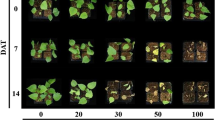Abstract
Phytoremediation is the most environmentally friendly remediation technology for heavy metal contaminated soil. However, the phytoremediation approach requires a long time to yield results, and the plants used must be economically profitable to maintain the sustainability of the process. Because high levels of bioethanol can be produced from sweet potatoes, an experiment was conducted by planting sweet potatoes in a lead-contaminated site to observe their growth and lead-uptake capacity, thereby enabling the evaluation of the phytoremediation efficiency of sweet potatoes. The lead content in the soil was approximately 6000 mg kg−1, and the phytoavailable Pb content was 1766 mg kg−1. Three starch-rich sweet potato varieties, Tainung No. 10 (TNG-10), Tainung No. 31 (TNG-31), and Tainung No. 57 (TNG-57), were used in the experiment. The results indicated that TNG-10, TNG-31, and TNG-57 had fresh root tuber yields of 94.5, 133.0, and 47.5 ton ha−1 year−1, produced 9450, 13,297, and 4748 L ha−1 year−1 of bioethanol, and removed 2.68, 7.73, and 3.22 kg ha−1 year−1 of lead, respectively. TNG-31 yielded the highest bioethanol production and the highest lead removal in the lead-contaminated site. Therefore, implementing phytoremediation by planting TNG-31 would decrease lead content and generate income, thereby rendering the sustainable and applicable activation of contaminated soil possible.

Similar content being viewed by others
References
Ahmad, M., Lee, S. S., Lim, J. E., Lee, S. E., Cho, J. S., Moon, D. H., Hashimoto, Y., & Ok, Y. S. (2014). Speciation and phytoavailability of lead and antimony in a small arms range soil amended with mussel shell, cow bone and biochar: EXAFS spectroscopy and chemical extractions. Chemosphere, 95, 433–441.
Baker, A. J. M. (1981). Accumulators and excluders-strategies in the response of plants to heavy metals. Journal of Plant Nutrition, 3(1–4), 643–654.
Boussen, S., Soubrand, M., Bril, H., Ouerfelli, K., & Abdeljaouad, S. (2013). Transfer of lead, zinc and cadmium from mine tailings to wheat (Triticum aestivum) in carbonated Mediterranean (Northern Tunisia) soils. Geoderma, 192, 227–236.
Brunetti, G., Farrag, K., Rovira, P. S., Nigro, F., & Senesi, N. (2011). Greenhouse and field studies on Cr, Cu, Pb and Zn phytoextraction by Brassica napus from contaminated soils in the Apulia region Italy. Geoderma, 160(3–4), 517–523.
Chu, C., & Wang, M. C. (1999). Bond Forms of heavy metals in polluted soil. Journal of the Chinese Agricultural Chemical Society, 37(1), 32–41.
Ginneken, L. V., Meers, E., Guisson, R., Ruttens, A., Elst, K., Tack, F. M. G., Vangronsveld, J., Diels, L., & Dejonghe, W. (2007). Phytoremediation for heavy metal-contaminated soils combined with bioenergy production. Journal of Environmental Engineering and Landscape Management, 15(4), 227–236.
Houben, D., Evrard, L., & Sonnet, P. (2013). Beneficial effects of biochar application to contaminated soils on the bioavailability of Cd, Pb and Zn and the biomass production of rapeseed (Brassica napus L.). Biomass and Bioenergy, 57, 196–204.
Jiang, J., Xu, R. K., Jiang, T. Y., & Li, Z. (2012). Immobilization of Cu(II), Pb(II) and Cd(II) by the addition of rice straw derived biochar to a simulated polluted Ultisol. Journal of Hazardous Materials, 229–230, 145–150.
Kim, K. R., Kim, J. G., Park, J. S., Kim, M. S., Owens, G., Youn, G. H., & Lee, J. S. (2012). Immobilizer-assisted management of metal-contaminated agricultural soils for safer food production. Journal of Environmental Management, 102, 88–95.
Larner, B. L., Seen, A. J., & Townsend, A. T. (2006). Comparative study of optimized BCR sequential extraction scheme and acid leaching of elements in the certified reference material NIST 2711. Analytica Chimica Acta, 556(2), 444–449.
Lai, Y. C., Li, Z. T., Jeng, T. L., & Tsai, W. H. (2008). Breeding of the new sweet potato variety, Tainung No. 73. J Taiwan Agric Res, 57(4), 279–294.
Lin, C. Y., & Lai, R. S. (2007). Evaluation of Taiwan bioethanol crops. Agriculture World, 287, 40–47.
Meers, E., Slycken, S. V., Adriaensenm, K., Ruttens, A., Vangronsveld, J., Laing, G. D., Witters, N., Thewys, T., & Tack, F. M. G. (2010). The use of bio-energy crops (Zea mays) for ‘phytoattenuation’ of heavy metals on moderately contaminated soils: a field experiment. Chemosphere, 78(1–2), 35–41.
Nelson, D. W., & Sommers, L. E. (1996). Total carbon, organic carbon, and organic matter. In: A. L. Page et al. (Eds.), Methods of soil analysis, part 2. Chemical Analysis, 2nd ed. Soil Sci. Amer. (pp. 961–1110). Madison.
Padmavathiamma, P. K., & Li, L. Y. (2010). Phytoavailability and fractionation of lead and manganese in a contaminated soil after application of three amendments. Bioresource Technology, 101(14), 5667–5676.
Singer, M. J., & Munns, D. N. (2002). Soil an introduction (5th ed.). New Jersey: Prentice Hall.
Tessier, A., Campbell, P. G. C., & Bisson, M. (1979). Sequential extraction procedure for the speciation of particulate trace metals. Analytical Chemistry, 51(7), 844–850.
Witters, N., Mendelsohn, R. O., Slycken, S. V., Weyens, N., Schreurs, E., Meers, E., Tack, F., Carleer, R., & Vangronsveld, J. (2012). Phytoremediation, a sustainable remediation technology? Conclusions from a case study. I: Energy production and carbon dioxide abatement. Biomass and Bioenergy, 39, 454–469.
Yang, J., Guo, H., Ma, Y., Wang, L., Wei, D., & Hua, L. (2010). Genotypic variations in the accumulation of Cd exhibited by different vegetables. Journal of Environmental Sciences, 22(8), 1246–1252.
Zemberyová, M., Barteková, J., & Hagarová, I. (2006). The utilization of modified BCR three-step sequential extraction procedure for the fractionation of Cd, Cr, Cu, Ni, Pb and Zn in soil reference materials of different origins. Talanta, 70(5), 973–978.
Zhu, Y. G., Chen, S. B., & Yang, J. C. (2004). Effects of soil amendments on lead uptake by two vegetable crops from a lead-contaminated soil from Anhui, China. Environment International, 30(3), 351–356.
Acknowledgments
The authors thank the Environmental Pollution Agency of the Republic of China for financially supporting this research.
Author information
Authors and Affiliations
Corresponding author
Rights and permissions
About this article
Cite this article
Cheng, SF., Huang, CY., Chen, KL. et al. Exploring the benefits of growing bioenergy crops to activate lead-contaminated agricultural land: a case study on sweet potatoes. Environ Monit Assess 187, 144 (2015). https://doi.org/10.1007/s10661-014-4247-y
Received:
Accepted:
Published:
DOI: https://doi.org/10.1007/s10661-014-4247-y




